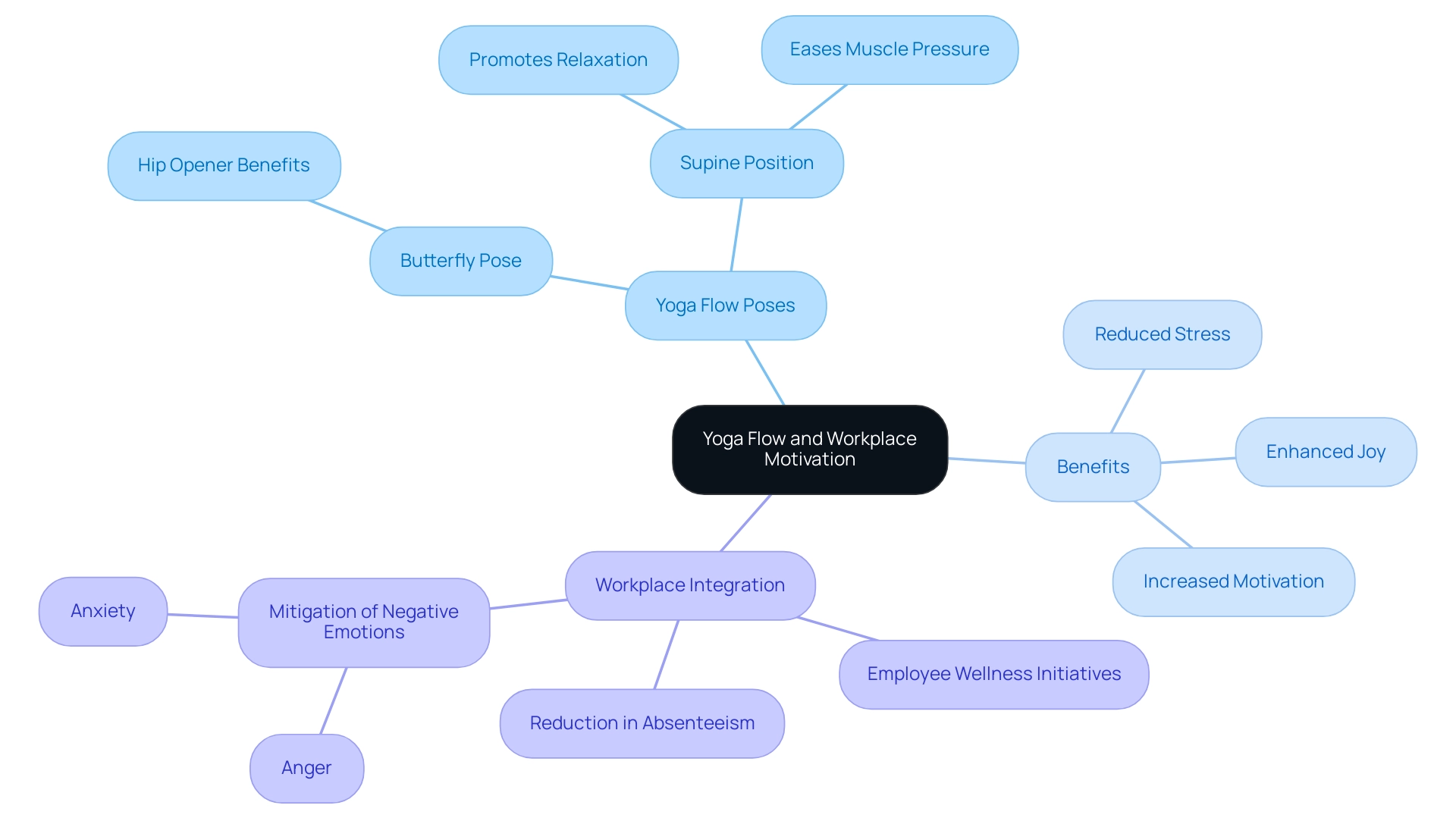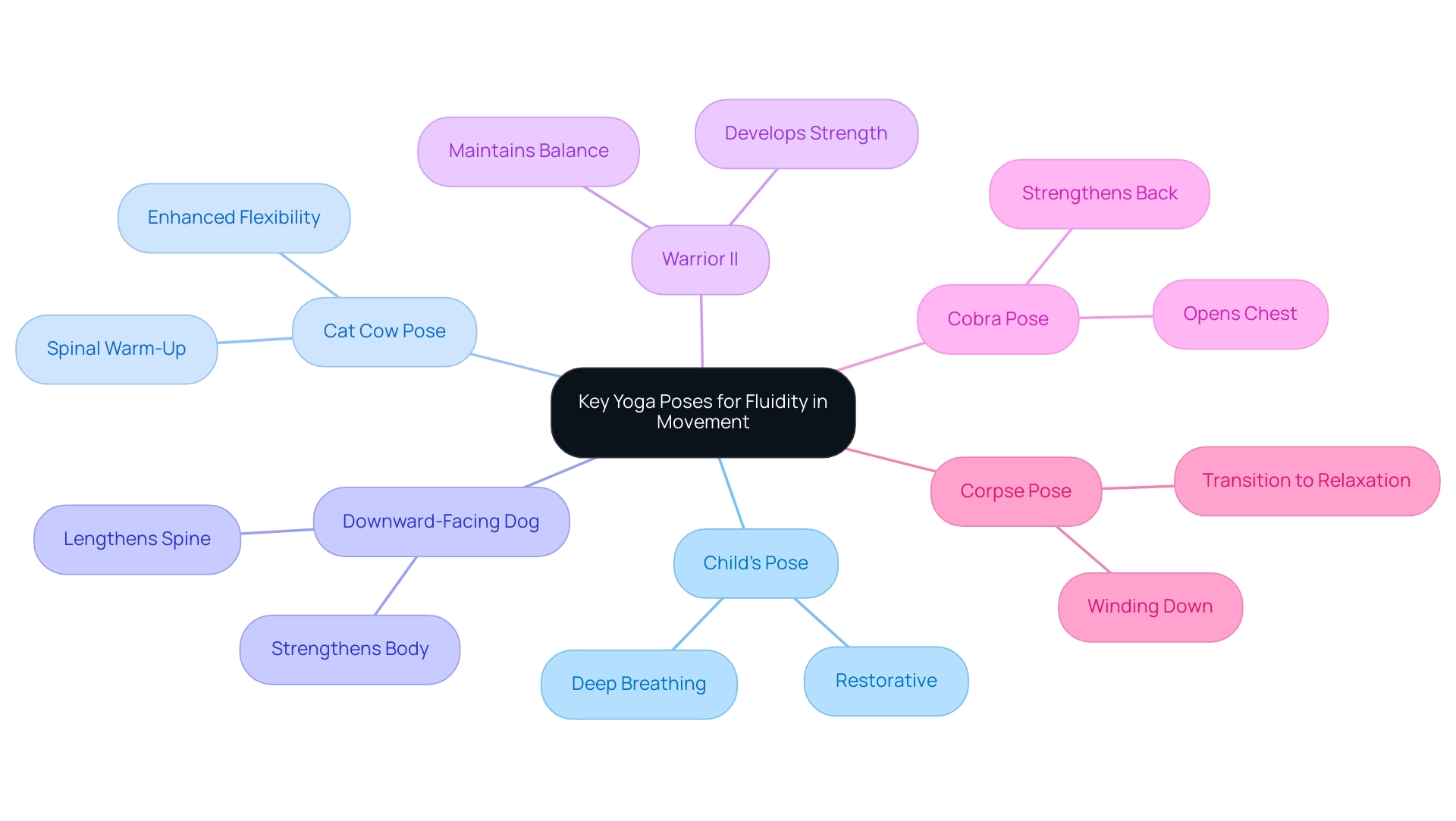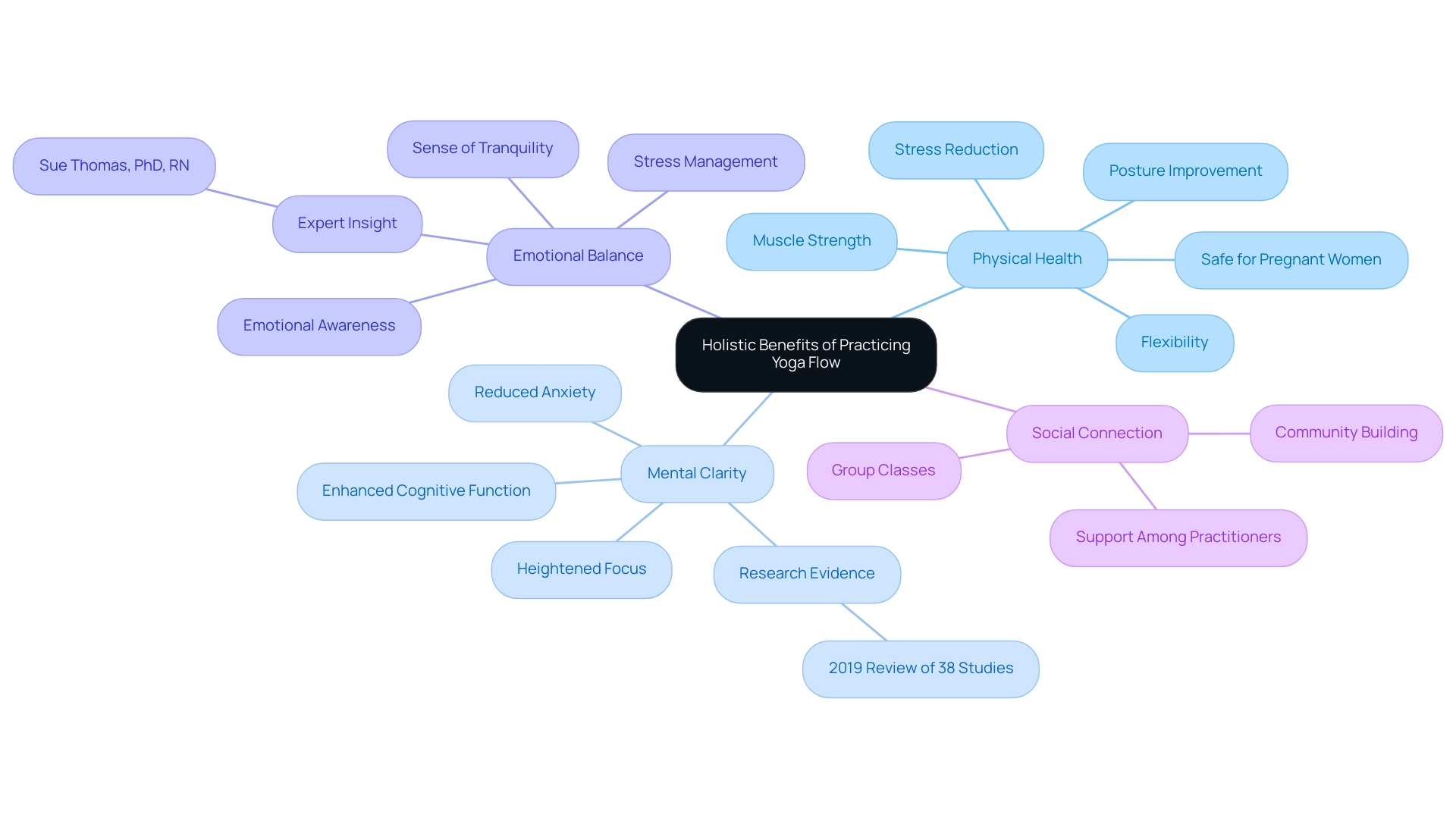Overview
Yoga flow poses enhance physical and mental well-being through fluid movement and breath synchronization, promoting a balanced practice that can significantly boost workplace motivation. The article supports this by detailing how regular yoga practice reduces stress and fatigue, while specific poses improve flexibility and emotional health, making it a valuable component of employee wellness initiatives.
Introduction
In a world where workplace stress and burnout are increasingly prevalent, the transformative power of yoga flow emerges as a beacon of hope for enhancing motivation and well-being. This dynamic practice, characterized by fluid transitions between poses, not only nurtures physical health but also fosters mental clarity and emotional balance. Recent studies reveal that employees who engage in regular yoga sessions experience significant reductions in stress and fatigue, paving the way for a more productive work environment.
By embracing the art of yoga flow, organizations can cultivate a culture of wellness, empowering their teams to thrive both personally and professionally. As the journey into the world of yoga unfolds, the benefits extend far beyond the mat, offering a holistic approach to nurturing a motivated and resilient workforce.
Understanding Yoga Flow: The Essence of Fluid Movement
Yoga flow poses, characterized by smooth transitions between positions, play a vital role in promoting a balanced practice that improves both physical and mental well-being. This approach encourages practitioners to unify breath with movement, creating a meditative and dynamic experience that can significantly boost motivation at work. Recent studies have indicated that employees who participate in regular physical activity, including stretching for at least 30 minutes three times per week, report higher levels of motivation and lower levels of fatigue and stress, which are key contributors to workplace motivation.
Certified Yoga Instructor Courtney Sullivan highlights the benefits of poses like the Butterfly Pose, noting:
- Butterfly Pose — a classic hip opener — can do a lot for you.
This illustrates the wider influence of yoga flow poses on emotional health, as participants engage in these exercises to alleviate tension, enhance joy, and detach from technology. Furthermore, workplace exercise programs have been linked with a notable reduction in absenteeism and presenteeism, emphasizing the importance of integrating yoga into employee wellness initiatives.
The Supine Position in Yoga, known for promoting relaxation and easing muscle pressure, showcases how specific poses can enhance performance effectiveness and overall workplace morale. Additionally, regular engagement can help mitigate negative emotions such as anger and anxiety, further supporting motivation. Embracing this essence is the first step toward mastering the art of yoga flow poses, which serve as a powerful tool for enhancing motivation and well-being in any workplace.

Key Yoga Poses for Achieving Fluidity in Movement
To cultivate fluidity in movement and enhance overall well-being, consider integrating these essential yoga positions into your practice, which aligns with Foresight Health Coaching’s commitment to holistic wellness:
- Child’s Pose: A restorative position that fosters relaxation and encourages deep, mindful breathing, setting a strong foundation for a centered practice.
- Cat Cow Pose: This flowing sequence warms up your spine and enhances flexibility, facilitating smoother transitions between poses.
- Downward-Facing Dog: Engaging in this position strengthens your entire body while lengthening the spine, paving the way for more fluid motion throughout your practice.
- Warrior II: Essential for developing strength and stability, this position helps maintain balance, crucial during transitional movements.
- Cobra Pose: By opening the chest and strengthening the back, Cobra Pose contributes to fluid upper body movement, enhancing your overall range of motion.
Incorporating the Corpse Pose at the end of your practice is vital for winding down, allowing you to absorb the benefits of your session, quiet your mind, and transition into relaxation or sleep. This is especially significant within workplace wellness programs, fostering a healthier mindset.
Mastering these poses enables practitioners to navigate their sessions with fluidity and confidence. As one instructor aptly noted, 'If you've practiced this discipline, you'd know it raises your heart rate like cardio does,' underscoring the vigorous benefits of these movements. With Emory Healthcare operating approximately 500 locations, integrating wellness initiatives like yoga can significantly enhance employee health and productivity.
Foresight Health Coaching offers tailored corporate memberships that include wellness workshops, nutritional guidance, and access to our health and wellness app, which supports clients in their wellness journeys. The Magnet® designation, acknowledged for quality patient care, demonstrates how such wellness approaches lead to superior outcomes, aligning with HR managers' interests in enhancing workplace health. By prioritizing these foundational poses and integrating them into Foresight's programs, you not only enhance your practice but foster a healthier mindset that resonates throughout the workplace.

Enhancing Athletic Performance Through Yoga Flow
Incorporating flow techniques into athletic training can be a game changer for enhancing performance across various sports. Here’s how:
- Improving Flexibility: By consistently practicing yoga, athletes can maintain a full range of motion, significantly reducing their risk of injuries. This is crucial for peak performance, as flexibility directly impacts an athlete's ability to execute movements efficiently.
- Enhancing Core Strength: Many yoga flow poses are designed to activate the core muscles, which are vital for stability and control in sports. A strong core contributes to better balance and agility, essential traits in high-performance athletes.
- Promoting Recovery: Yoga flow poses serve as an effective tool for muscle recovery, helping to alleviate soreness and tension. This facilitates more productive training sessions, allowing athletes to push their limits without the burden of excessive fatigue.
- Boosting Mental Focus: The meditative elements of these yoga flow poses enhance concentration, empowering athletes to remain present and engaged during performances. Improved mental clarity translates to better decision-making and execution under pressure.
The findings from a recent study involving student circus artists, who attended 90-minute sessions of the practice over 8 weeks, support these claims, indicating that it can significantly enhance athletic performance. Additionally, as mentioned by Elena Grilli Cadieux from the University of Quebec in Montreal, there is a need for more rigorous trials to fully understand the impact of this practice on performance, highlighting the importance of addressing reporting inconsistencies and theoretical limitations.
With the initial findings from the BYP-A program indicating that circus artists benefited from enhanced psychological health and performance-related mental states, the call for further exploration of mindfulness interventions in performance fields is stronger than ever. A case study titled "Conclusions on the Practice's Impact" also supports the notion that athletes engaging in this practice reported notable improvements in mindfulness and sleep quality—factors that significantly contribute to overall performance. By adopting a dynamic practice, athletes can unlock their full potential, cultivate resilience, and achieve superior results in their respective sports.
The path to improved athletic performance starts with the straightforward yet impactful discipline of stretching.

The Art of Sequencing: Creating a Smooth Yoga Flow
Developing a seamless routine with yoga flow poses necessitates careful and deliberate arrangement of movements. Here are some key tips to elevate your routine:
- Start with Warm-Up Exercises: Initiate your practice with foundational warming exercises like Cat Cow and Downward-Facing Dog. These yoga flow poses effectively prepare the body for deeper stretches and movements.
- Transition Gradually: The progression of your routine should feel natural. Consider how the body moves when transitioning between yoga flow poses; for example, seamlessly shift from Warrior II to Extended Side Angle, allowing for a fluid experience.
- Include Balancing Positions: Enhance stability and focus by incorporating balancing positions like Tree Position. Practicing yoga flow poses not only challenges practitioners but also promotes mental clarity.
- Incorporate yoga flow poses that specifically target opening the hips to enhance flexibility and overall movement, making the session more effective.
- Cool Down with Restorative Yoga Flow Poses: Conclude your routine with gentle yoga flow poses, such as Child’s Position, to facilitate relaxation and recovery. This restorative phase is crucial for integrating the benefits of your practice.
Research suggests that an effective sequence of yoga flow poses should consist of:
- 25% warming poses
- 50% standing poses
- 25% cooling poses
This ensures a balanced flow that promotes well-being. Additionally, Odynets T et al. studied the influence of structured movement on heart rate variability in breast cancer patients in 2019, highlighting the physiological advantages of a well-organized routine.
By mastering the art of sequencing yoga flow poses, as demonstrated in case studies like 'Harnessing Shiva's Energy through Yoga,' you can create an approach that feels effortless and enjoyable, leading to transformative growth for all participants. As noted by RS, significant enhancements in this discipline can be attained through careful attention to sequencing.

The Holistic Benefits of Practicing Yoga Flow
Participating in a consistent sequence of postures can result in substantial holistic advantages that improve overall wellness. Here are some key advantages:
- Physical Health: Consistent practice of this discipline enhances flexibility, strengthens muscles, and improves posture, which collectively contribute to overall physical fitness and well-being. Importantly, physical activities such as this practice are generally safe for pregnant women and may help decrease stress, anxiety, and depression during this critical time.
- Mental Clarity: The meditative aspects of this practice foster heightened mental focus and significantly reduce anxiety levels, leading to enhanced cognitive function. A comprehensive review of 38 studies involving 2,295 participants demonstrated substantial benefits of this practice on anxiety symptoms, highlighting its effectiveness as a mental health tool. Moreover, these studies gathered demographic information and evaluated various forms of exercise and health factors using a 65-item questionnaire, highlighting the thoroughness of the research.
- Emotional Balance: This form of exercise enhances emotional awareness, allowing individuals to better handle stress and attain a sense of tranquility. As Sue Thomas, PhD, RN from the University of Maryland School of Nursing emphasizes, the holistic advantages of this practice are invaluable for maintaining emotional equilibrium.
- Social Connection: Group classes not only enhance physical practices but also build community and support among practitioners, fostering a sense of belonging.
By dedicating time to a regular routine of yoga flow poses, individuals can experience transformative effects on their physical, mental, and emotional health. For instance, a systematic review on the effects of this practice on chronic nonspecific neck pain revealed that participants reported reduced pain and improved quality of life. This aligns with the holistic benefits of yoga, as the latest research continues to underscore its positive impact on mental health and clarity.
The time to embrace this practice is now.

Conclusion
The integration of yoga flow into workplace wellness initiatives presents a unique opportunity to enhance employee motivation and overall well-being. By embracing the fluidity of yoga, organizations can foster an environment that not only reduces stress and fatigue but also promotes mental clarity and emotional balance. The compelling evidence from various studies indicates that regular yoga practice can lead to significant improvements in productivity and morale, making it an invaluable tool for HR managers aiming to create a healthier workplace culture.
Incorporating key yoga poses into daily routines, such as:
- Child’s Pose
- Downward-Facing Dog
- Warrior II
can empower employees to cultivate resilience and enhance their physical and mental capabilities. The benefits of these practices extend beyond the individual, positively influencing team dynamics and fostering a sense of community. As employees engage in yoga, they not only improve their own well-being but also contribute to a collective culture of support and motivation.
Ultimately, the journey towards a motivated and resilient workforce begins with the simple yet profound practice of yoga flow. Organizations that prioritize this holistic approach to well-being are not only investing in their employees but also paving the way for a more productive and harmonious workplace. Now is the time to take action and embrace the transformative power of yoga, ensuring that teams thrive both personally and professionally.




